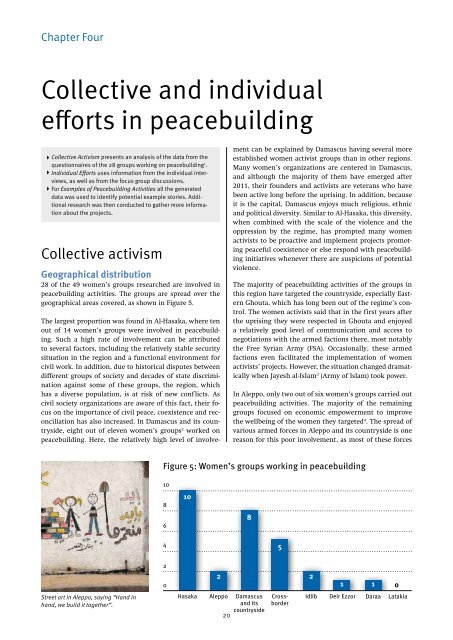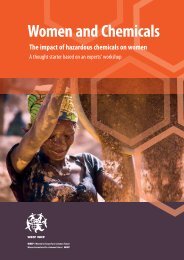future now”
YAO19
YAO19
You also want an ePaper? Increase the reach of your titles
YUMPU automatically turns print PDFs into web optimized ePapers that Google loves.
Chapter Four<br />
Collective and individual<br />
efforts in peacebuilding<br />
4Collective Activism presents an analysis of the data from the<br />
questionnaires of the 28 groups working on peacebuilding 1 .<br />
4Individual Efforts uses information from the individual interviews,<br />
as well as from the focus group discussions.<br />
4For Examples of Peacebuilding Activities all the generated<br />
data was used to identify potential example stories. Additional<br />
research was then conducted to gather more information<br />
about the projects.<br />
Collective activism<br />
Geographical distribution<br />
28 of the 49 women’s groups researched are involved in<br />
peacebuilding activities. The groups are spread over the<br />
geographical areas covered, as shown in Figure 5.<br />
The largest proportion was found in Al-Hasaka, where ten<br />
out of 14 women’s groups were involved in peacebuilding.<br />
Such a high rate of involvement can be attributed<br />
to several factors, including the relatively stable security<br />
situation in the region and a functional environment for<br />
civil work. In addition, due to historical disputes between<br />
different groups of society and decades of state discrimination<br />
against some of these groups, the region, which<br />
has a diverse population, is at risk of new conflicts. As<br />
civil society organizations are aware of this fact, their focus<br />
on the importance of civil peace, coexistence and reconciliation<br />
has also increased. In Damascus and its countryside,<br />
eight out of eleven women’s groups 2 worked on<br />
peacebuilding. Here, the relatively high level of involvement<br />
can be explained by Damascus having several more<br />
established women activist groups than in other regions.<br />
Many women’s organizations are centered in Damascus,<br />
and although the majority of them have emerged after<br />
2011, their founders and activists are veterans who have<br />
been active long before the uprising. In addition, because<br />
it is the capital, Damascus enjoys much religious, ethnic<br />
and political diversity. Similar to Al-Hasaka, this diversity,<br />
when combined with the scale of the violence and the<br />
oppression by the regime, has prompted many women<br />
activists to be proactive and implement projects promoting<br />
peaceful coexistence or else respond with peacebuilding<br />
initiatives whenever there are suspicions of potential<br />
violence.<br />
The majority of peacebuilding activities of the groups in<br />
this region have targeted the countryside, especially Eastern<br />
Ghouta, which has long been out of the regime’s control.<br />
The women activists said that in the first years after<br />
the uprising they were respected in Ghouta and enjoyed<br />
a relatively good level of communication and access to<br />
negotiations with the armed factions there, most notably<br />
the Free Syrian Army (FSA). Occasionally, these armed<br />
factions even facilitated the implementation of women<br />
activists’ projects. However, the situation changed dramatically<br />
when Jayesh al-Islam 3 (Army of Islam) took power.<br />
In Aleppo, only two out of six women’s groups carried out<br />
peacebuilding activities. The majority of the remaining<br />
groups focused on economic empowerment to improve<br />
the wellbeing of the women they targeted 4 . The spread of<br />
various armed forces in Aleppo and its countryside is one<br />
reason for this poor involvement, as most of these forces<br />
Figure 5: Women’s groups working in peacebuilding<br />
10<br />
8<br />
6<br />
10<br />
8<br />
4<br />
5<br />
2<br />
0<br />
2<br />
Street art in Aleppo, saying “Hand in<br />
hand, we build it together”.<br />
Hasaka Aleppo Damascus<br />
and its<br />
20<br />
countryside<br />
Crossborder<br />
2<br />
1 1 0<br />
Idlib Deir Ezzor Daraa Latakia



